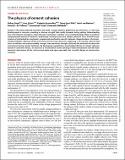The physics of cement cohesion
Author(s)
Goyal, Abhay; Palaia, Ivan; Ioannidou, Katerina; Ulm, Franz-Josef; van Damme, Henri; Pellenq, Roland J-M; Trizac, Emmanuel; Del Gado, Emanuela; ... Show more Show less
DownloadPublished version (559.9Kb)
Publisher with Creative Commons License
Publisher with Creative Commons License
Creative Commons Attribution
Terms of use
Metadata
Show full item recordAbstract
Cement is the most produced material in the world. A major player in greenhouse gas emissions, it is the main binding agent in concrete, providing a cohesive strength that rapidly increases during setting. Understanding how such cohesion emerges is a major obstacle to advances in cement science and technology. Here, we combine computational statistical mechanics and theory to demonstrate how cement cohesion arises from the organization of interlocked ions and water, progressively confined in nanoslits between charged surfaces of calcium-silicate-hydrates. Because of the water/ions interlocking, dielectric screening is drastically reduced and ionic correlations are proven notably stronger than previously thought, dictating the evolution of nanoscale interactions during cement hydration. By developing a quantitative analytical prediction of cement cohesion based on Coulombic forces, we reconcile a fundamental understanding of cement hydration with the fully atomistic description of the solid cement paste and open new paths for scientific design of construction materials.
Date issued
2021-08Department
MultiScale Materials Science for Energy and Environment, Joint MIT-CNRS Laboratory; Massachusetts Institute of Technology. Department of Civil and Environmental EngineeringJournal
Science Advances
Publisher
American Association for the Advancement of Science (AAAS)
Citation
Goyal, Abhay, Palaia, Ivan, Ioannidou, Katerina, Ulm, Franz-Josef, van Damme, Henri et al. 2021. "The physics of cement cohesion." Science Advances, 7 (32).
Version: Final published version
ISSN
2375-2548